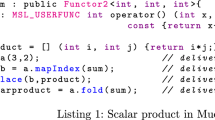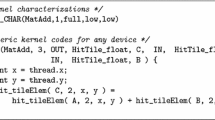Abstract
During the last decade, parallel processing architectures have become a powerful tool to deal with massively-parallel problems that require high performance computing (HPC). The last trend of HPC is the use of heterogeneous environments, that combine different computational processing devices, such as CPU-cores and graphics processing units (GPUs). Maximizing the performance of any GPU parallel implementation of an algorithm requires an in-depth knowledge about the GPU underlying architecture, becoming a tedious manual effort only suited for experienced programmers. In this paper, we present TuCCompi, a multi-layer abstract model that simplifies the programming on heterogeneous systems including hardware accelerators, by hiding the details of synchronization, deployment, and tuning. TuCCompi chooses optimal values for their configuration parameters using a kernel characterization provided by the programmer. This model is very useful to tackle problems characterized by independent, high computational-load independent tasks, such as embarrassingly-parallel problems. We have evaluated TuCCompi in different, real-world, heterogeneous environments using the all-pair shortest-path problem as a case study.













Similar content being viewed by others
References
Foster, I.: Designing and building parallel programs: concepts and tools for parallel software engineering. Addison-Wesley Longman Publishing Co., Inc., Boston (1995)
Hoelzle, U., Barroso, L.A.: The datacenter as a computer: an introduction to the design of warehouse-scale machines, 1st edn. Morgan and Claypool Publishers, San Rafael (2009)
Cirne, W., Paranhos, D., Costa, L., Santos-Neto, E., Brasileiro, F., Sauve, J., Silva, F.A.B., Barros, C., Silveira, C.: Running bag-of-tasks applications on computational grids: the mygrid approach. In: Proceedings of international conference on parallel processing (ICPP 2003), pp. 407–416 (2003)
Mangharam, R., Saba, A.A.: Anytime algorithms for GPU architectures. In: Proceedings of the 2011 IEEE 32nd real-time systems symposium, RTSS ’11, pp. 47–56. Washington, DC, IEEE Computer Society (2011)
Taylor, M.: Bitcoin and the age of bespoke silicon. In: Compilers, architecture and synthesis for embedded systems (CASES), 2013 international conference on, pp. 1–10 (2013)
Brodtkorb, A.R., Dyken, C., Hagen, T.R., Hjelmervik, J.M., Storaasli, O.O.: State-of-the-art in heterogeneous computing. Sci. Program. 18(1), 1–33 (2010)
Reyes, R., de Sande, F.: Optimization strategies in different CUDA architectures using llCoMP. Microprocess. Microsyst. 36(2), 78–87 (2012)
Liang, T., Li, H., Chiu, J.: Enabling mixed openMP/MPI programming on hybrid CPU/GPU computing architecture. In: Proceedings of the 2012 IEEE 26th international parallel and distributed processing symposium workshops & PhD forum (IPDPSW), pp. 2369–2377. IEEE, Shanghai (2012)
Torres, Y., Gonzalez-Escribano, A., Llanos, D.: Using Fermi architecture knowledge to speed up CUDA and OpenCL programs. In: Parallel and distributed processing with applications (ISPA), 2012 IEEE 10th international symposium on, pp. 617–624 (2012)
Torres, Y., Gonzalez-Escribano, A., Llanos, D.R.: uBench: exposing the impact of CUDA block geometry in terms of performance. J. Supercomput. 65(3), 1150–1163 (2013)
Yang, C., Huang, C., Lin, C.: Hybrid CUDA, OpenMP, and MPI parallel programming on multicore GPU clusters. Comput. Phys. Commun. 182, 266–269 (2011)
Howison, M., Bethel, E., Childs, H.: Hybrid parallelism for volume rendering on large-, multi-, and many-core systems. Vis. Comput. Graph. IEEE Trans. 18(1), 17–29 (2012)
Steuwer, M., Gorlatch, S.: SkelCL: enhancing OpenCL for high-level programming of multi-GPU systems. In: LNCS, ser, Malyshkin, V. (eds.) Parallel computing technologies, p. 258272. Springer, Berlin (2013)
Hugo, A.-E., Guermouche, A., Wacrenier, P.-A., Namyst, R.: Composing multiple starPU applications over heterogeneous machines: a supervised approach. In: Proceedings of IEEE 27th IPDPSW’13, pp. 1050–1059. Washington, USA: IEEE, (2013)
Dastgeer, U., Enmyren, J., Kessler, C. W.: Auto-tuning SkePU: a multi-backend skeleton programming framework for multi-GPU systems. In: Proceedings of the 4th IWMSE, pp. 25–32. New York, NY, USA: ACM, (2011)
Reyes, R., López-Rodríguez, I., Fumero, J.J., de Sande, F.: accULL: an OpenACC implementation with CUDA and OpenCL support. In: Proceedings of the 18th conference on parallel processing, ser. EuroPar’12, pp. 871–882. Springer, Berlin (2012)
Farooqui, N., Kerr, A., Diamos, G.F., Yalamanchili, S., Schwan, K.:A framework for dynamically instrumenting GPU compute applications within GPU Ocelot. In: Proceedings of 4th workshop on GPGPU: CA, USA, 5 Mar 2011. ACM, p. 9 (2011)
Pai, S., Thazhuthaveetil, M.J., Govindarajan, R.: Improving GPGPU concurrency with elastic kernels. SIGPLAN Not. 48(4), 407–418 (2013)
NVIDIA.: NVIDIA CUDA programming guide 6.0, (2014)
Kirk, D. B., Hwu, W.W.: Programming massively parallel processors: a hands-on approach, 1st edn. Morgan Kaufmann Publishers Inc., San Francisco, CA, USA (2010)
Dijkstra, E.W.: A note on two problems in connexion with graphs. Numerische Mathematik 1, 269–271 (1959)
Crauser, A., Mehlhorn, K., Meyer, U., Sanders, P.: A parallelization of Dijkstra’s shortest path algorithm. In: LNCS, ser, Brim, L., Gruska, J., Zlatuška, J. (eds.) Mathematical foundations of computer science 1998, pp. 722–731. Springer, Berlin (1998)
Ortega-Arranz, H., Torres, Y., Llanos, D.R., Gonzalez-Escribano, A.: A new GPU-based approach to the shortest path problem. In: High performance computing and simulation (HPCS). international conference on 2013, pp. 505–512 (2013)
Martín, P., Torres, R., Gavilanes, A.: CUDA solutions for the SSSP problem. In: LNCS, ser, Allen, G., Nabrzyski, J., Seidel, E., van Albada, G., Dongarra, J., Sloot, P. (eds.) Computational Science: ICCS 2009, pp. 904–913. Springer, Berlin (2009)
Acknowledgments
The authors would like to thank Javier Ramos López for his support with technical issues. This research has been partially supported by Ministerio de Economía y Competitividad and ERDF program of the European Union: CAPAP-H5 network (TIN2014-53522-REDT), MOGECOPP project (TIN2011-25639); Junta de Castilla y León (Spain): ATLAS project (VA172A12-2); and the COST Program Action IC1305: NESUS.
Author information
Authors and Affiliations
Corresponding author
Rights and permissions
About this article
Cite this article
Ortega-Arranz, H., Torres, Y., Gonzalez-Escribano, A. et al. TuCCompi: A Multi-layer Model for Distributed Heterogeneous Computing with Tuning Capabilities. Int J Parallel Prog 43, 939–960 (2015). https://doi.org/10.1007/s10766-015-0349-6
Received:
Accepted:
Published:
Issue Date:
DOI: https://doi.org/10.1007/s10766-015-0349-6




